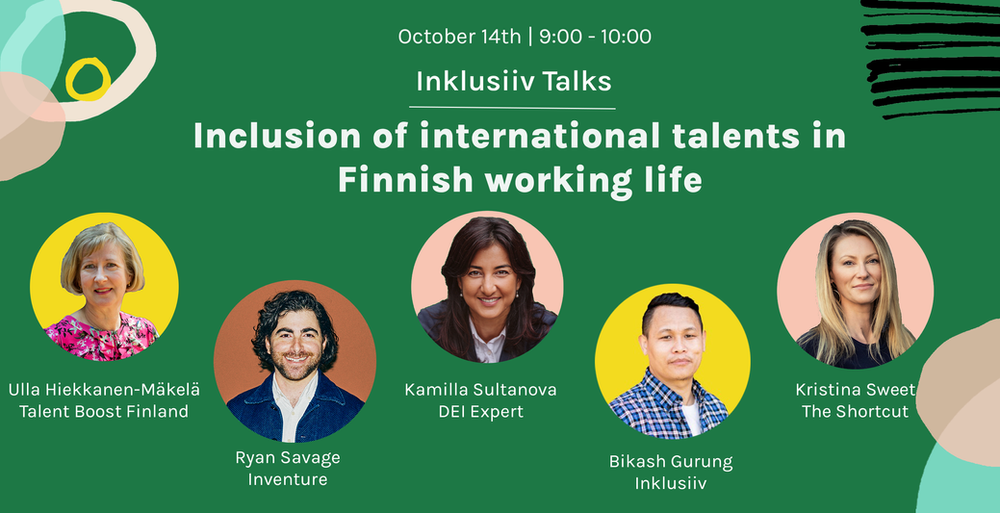The inclusion of international talents in Finnish working life is hindered by many structural barriers such as lengthy and unclear bureaucracy, network-based job markets, lack of preparedness or conscious or unconscious fear of change in Finnish organizations when it comes to diverse recruitment practices. In the recent Inklusiiv Talks, we focused on tackling this important topic with our guest speakers. Here are key takeaways from the event discussion – four structural barriers to the inclusion of international talents and how to overcome them.
Many of the recent articles, PR efforts and media pieces focus on how to attract highly qualified individuals and their families to work in Finland using different targeting and branding strategies. This narrative overlooks the fact that international professionals in Finland continue to find it difficult to integrate into Finnish working life. It is vital to first address the fundamental structural barriers such as lengthy and unclear immigration processes, a networks-based job market and strict language requirements. These make it challenging and even unpleasant for people to settle into working-life in Finland, affecting also their personal life.
These structural barriers are something which country branding alone can’t solve. In the worst case scenario, we create a broken pipeline where we succeed in encouraging international talent to move to Finland, but on arrival they get stuck having to battle bureaucratic nightmares, difficult language barriers and inaccessible social networks which hide the majority of work opportunities. Heavy branding campaigns might prove counterproductive when the reality experienced by international arrivals is different to what they were promised, as we’ve seen recently.
It’s time to shed more light on the uncovered crucial topics and barriers in the international talent conversation that have not been addressed enough. From our recent Inklusiiv Talks discussion with guest speakers Kamilla Sultanova (DEI expert), Kristina Sweet, (CEO at The Shortcut) Ryan Savage (Head of Talent at Inventure) and Ulla Hiekkanen-Mäkelä (Head of Talent Boost Finland), we have collected four barriers to inclusion for international talents in Finnish working life, and practical solutions on how to overcome them.
1. The majority of jobs are allocated through networks – and organizations need to do something about it
Finland is a small country where up to 80 percent of jobs are never openly advertised but rather allocated through networks. International talent who arrive in Finland without having secured a job in advance are at a significant disadvantage and end up having to compete for a smaller pool of positions with many other candidates. This is true even for international students who have completed their degrees in Finland, but may not have had equal opportunities to build networks during their studies due to limited work experience opportunities or language barriers.
It is irresponsible to encourage people to move to a country for work when the job market is not open for them and jobs might not be available for their spouses.
Companies and organizations need to think of solutions for how to make it easier for newcomers and existing international talents to find a job that matches their expertise. Mentoring programs are one practical way to help people build those needed networks. These can give people context and relevance so they know how to use their time efficiently when it comes to finding a job that matches their experience.
“Companies should realize that this kind of social capital exchange leads to economic outcomes. To make mentoring programs thrive, companies need to take an activist approach, see them as a commitment to foster diversity and get needed resources for community engagement activities. Mentoring really changes lives and it’s a win-win solution for all. Mentoring can be used as a strategic tool for recruiting your potential employee, this can save ca. 20 000€ in recruitment and onboarding costs”, Kamilla Sultanova points out.
Companies can also facilitate the inclusion of international talent in Finnish working life by thinking how they can shape their talent pipeline for people outside the traditional path to organization.
“Companies and public sector organizations can ask themselves if they have a story that international students and talents can relate to, or if international students and talents are seen, heard and valued in their employer branding approach. To show they mean it, they should also make sure they have paid internships available.”, Kamilla says.
2. Finnish bureaucracy and strict language requirements make integration difficult – and it can prevent Finland from attracting and retaining talent
Finnish bureaucracy is rigid and hinders international talent attraction. The government needs to address and fix the structural problems in our immigration services, permit processes and language requirements in order to enable people to better integrate into Finnish society and working life.
“Companies won’t wait for the government to take action to fix these problems. We see a lot of companies taking things into their own hands and making sure that the employees that they’ve brought to Finland are getting the services and support they need. This help can be something very practical, like help with finding housing, spotting good places to live or getting a bank account. All of these things are quite burdensome here in Finland”, Ryan Savage says.
Strict language requirements and hardships to get recognition for your qualifications are examples of structural challenges making it hard for international talents and their spouses to integrate into Finnish working life. There are international talents that have required expertise and experience but can’t even apply for a job because they can’t meet the strict requirements for certain education or knowledge of Finnish and Swedish languages.
Something we need to remember that talent is mobile these days and talent sub groups have very different needs when it comes to integration
“Something we need to remember that talent is mobile these days and talent sub groups have very different needs when it comes to integration. People that move to Finland for a job can leave the country in three years for another job opportunity somewhere else. Learning the Finnish language might not be a priority if you work in English and are not planning to stay”, Ryan continues.
Another challenge is that the current narrative has focused mainly on attracting talented individuals with certain professional backgrounds. This current approach to “international talents” is exclusive because it overlooks people who don’t match the ideal of so-called “highly qualified professionals”. This definition needs to include professionals from all sorts of backgrounds as well as experience levels – not just the tech “super brains” from Silicon Valley. Creating fast track processes for the selected few means creating inequality of experience and opportunity.
3. The fear of starting the change prevents Finnish organizations from diversifying – taking action on diversity, equity & inclusion is an important step
One barrier of inclusion can be found inside Finnish organizations – the unconscious or conscious fear of starting the change towards a more inclusive culture.
“One of the main barriers in the company side to hire international talent is that companies are afraid of their own culture. Many of the companies in Finland, especially the small and medium size ones, have a very Finnish company culture. When you hire the first international talent, it changes the culture and how the company works internally”, says Ulla Hiekkanen-Mäkelä.
Many companies are starting to realize the business benefits of building more diverse teams, but many of the organizations are at the very beginning of their DEI journey.
Many companies are starting to realize the business benefits of building more diverse teams, but many of the organizations are at the very beginning of their DEI journey. Lack of diversity is a challenge also for organizations providing services to international talent.
“Having all Finnish teams building services for international people does not necessarily work”, Kristina Sweet points out.
If Finnish organizations want to attract more international talent and build more diverse teams, they need to take action on advancing diversity, equity and inclusion and see these topics as a strategic priority. And most importantly – not be afraid of starting the change.
“Fear of starting the change prevents Finnish organizations from diversifying. They need to identify the roadblocks of their Diversity, Equity and Inclusion work and focus more on recruitment, cross cultural competencies and seeing life from other people’s perspective. It’s about putting empathy better into action and leveling it with ambition”, Kamilla sums up.
4. Inefficient funding mechanisms lead to fragmented services and a project based environment – which makes it hard to continue things that work
One barrier of inclusion is the fragmented nature of services provided to international talent in Finland. Fragmented budgeting and lack of earmarked funding makes it difficult for career services and universities secure human and financial resources to provide the best possible services and support for international talent.
“This project-based culture brings a lot of great ideas, experiments, initiatives and best practices but there is not enough willpower or commitment to continue something that really works”, Kamilla tells.
There are a lot of different active organizations and communities in Finland that provide support for international talent. People come to Finland from very different entry points and depending on your path to Finland, you are offered different services. Right now, these services operate separately and it is difficult for people to know about them.
We need to find a way to centralize information about the support and services available for foreign talent.
“We need to find a way to centralize information about the support and services available for foreign talent. This could be a portal that includes all communities, organizations and services that support both the newcomers as well as people building a life here and looking for a better integration experience”, says Kristina.
It’s also about targeting that funding effectively to services and nonprofits that provide the needed support for international talent and represent the talent groups the funded projects are aiming for, this way combining skillset of teams that have both lived multicultural experiences and expertise from public sector administration.
“The funding and even tenders should be earmarked for example to services with different languages depending on the needs of different regions and recruit people who represent the customer base”, Kamilla says.
If your organization wants to promote inclusion for international talents, reflect on whether you are committed to changing your company culture and to creating a welcoming and safe environment for all. Have you thought about shaping the talent pipeline to be more inclusive for international talent? Could you utilize mentoring or other community activities as a part of your diverse recruitment strategy? Are you seeing DEI as a strategic priority? Have you advocated for more efficient and welcoming immigration services? We need more of these concrete actions and less talk about attracting talent to Finland.
Did you miss the event? No worries, you can watch the recording on our Youtube channel.
Here you can find useful best practices for recruitment (various employers).
Here you can find international recruitment guide in different languages.


